Review process
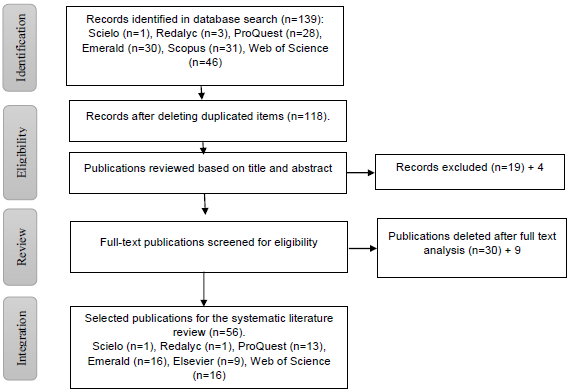
Note. Prepared by the authors.
A systematic review of the organizational learning and performance literature
(*)Cynthia Lizeth Martínez Aragón; (**)Norma Aguilar Morales
(*)Universidad Juárez Autónoma de Tabasco
Villahermosa, Tabasco, México
cynthiamrtz@hotmail.com
(**)Universidad Juárez Autónoma de Tabasco
Villahermosa, Tabasco, México
gialca@hotmail.com
ABSTRACT
Organizations from all sectors are in a constant struggle to survive and face changes in the globalized and complex environment. Where variables related to human resources that improve performance become relevant to adapt. Under this scenario, the purpose of this document is to identify the relationship between organizational learning and performance, through a systematic review of the literature where selection and inclusion criteria were established, as well as a research strategy. Among the primary findings, it stands out that countries belonging to Asia have been more focused on these issues, since most of the articles reviewed come from there and most of them have a quantitative approach. Furthermore, some researches added variables such as knowledge management, innovation, transformational leadership, among others. It was concluded that these are important subjects, which have been studied very little, and that the qualitative and mixed approach were studied to a lower extent. Therefore, an investigation of both variables has the potential to be innovative and interesting for academy, as well as for entrepreneurs and managers who wish to increase performance.
KEY WORDS: Organizational learning; Performance; Systematic review; Organizations.
INTRODUCTION
The environment in which organizations are immersed is complex and unpredictable, which has forced them to generate strategies that allow them to face adversities and to subsist. According to Khunsoonthornkit and Panjakajornsak (2018) in recent years, prosperous countries have shown greater interest in research and have focused on the development of both public and private companies, where the research of different variables is emphasized. Organizational learning and performance are an essential part for creating a systematic development, furthermore, they are variables that companies consider in order to adapt to changes and position themselves in the market, to face their competitors.
In addition to the aforementioned, Zhu, et al. (2018) mention that performance is increased when organizational learning is strong and consolidated, or, when a company has a high performance, its operation could be better if it has a high level of learning. However, learning is not usually a simple process and it is not always possible for companies to transmit knowledge easily among the members of the organization. This has a direct impact on their performance and consequently on the achievement of objectives, since knowledge is found within a single person and not in all those who should have it. Sometimes it occurs that the person, who has the knowledge, ends his working relationship with the company and the company is left without that valuable information since it does not know how to transmit it to others.
Moreover, according to Saunila, et al. (2015), the literature on performance has left out reflective work practices, where the members of the organization learn with the help of their own and other people's work experienced. This is concerning because these are essential aspects to achieve a better performance in the company, and since the learning process allows them to develop personally and professionally. Confirming the above, Londoño-Patiño and Acevedo-Álvarez (2018) affirm that an organization with a low capacity to develop learning is oriented to have a low performance.
As mentioned above, it is possible to highlight the importance of organizational learning because it is through this that knowledge can be acquired and shared. Ali, et al. (2020) mention that organizational learning benefits performance and that it is often considered a source of competitive advantage for companies that give importance to study and implement it properly.
Likewise, Bhaskar and Mishra (2017) state that competition in all sectors is usually changing, forcing companies to generate changes, update, learn and unlearn in order to survive or position themselves, in order to achieve this, it is important to create a comparative advantage that can be generated through the proper management of organizational learning. Therefore, Migdadi (2021) proposes that when conducting studies on organizational learning capacity, it is possible to obtain results that will allow managers and entrepreneurs to establish practices and provide the necessary resources to people to increase their effort and improve learning.
In this sense, Nonaka and Takeuchi (2007) propose that organizations over time have managed to remain and be successful through the creation of knowledge within the organization. In other words, it is necessary to generate knowledge and be able to share it among other members, in order to later apply it in the creation of new products, services or processes of the company. This ability is an important aspect for an organization that aims to generate a competitive advantage that positions it within the market in which it is located.
In addition, it is considered that learning, specifically informal learning, fosters positive attitudes that prevent workers from quitting their jobs, by creating a commitment, which is of interest to managers. By having employees committed to the organization, it is easier to increase performance, achieving the fulfillment of objectives and a more enjoyable work environment (Ryu & Moon, 2019; Yoon, et al., 2018).
However, Alcántara (2020) mentions that the current SARS-COV-2 health emergency has harmed millions of organizations, as they are paralyzed or working with the new normality. This will test their capacity to adapt and recover, which will depend greatly on learning and their ability to improve their performance in order to adapt to the complex environment and face competitors.
As it has been mentioned, organizations are stagnant and at risk of disappearing. Under this scenario, the purpose of this article is to identify the current literature on organizational learning and performance through a systematic literature review that cover the annual period of 2011-2020 so the results and conclusions obtained from the document, allow researchers and managers of companies to create proposals for improvement in order to survive and become competitive, avoiding closing down and recession of the economy.
DEVELOPMENT
Methods
In order to achieve the established objective, a systematic literature review was conducted, which, according to Benet, et al. (2015) is a way of identifying, evaluating and interpreting both theoretical and empirical studies available on a specific topic or phenomenon. Additionally, it is important to mention that it is considered a secondary study because it is made up of the analysis of primary studies that have already been conducted.
For its implementation, the structure proposed by Fortich (2013) was used, which consists of the following elements: structured summary, background, objectives of the review, search strategy, selection criteria, results and analysis of results; at the end, the conclusions and recommendations proposed by the authors are presented. Likewise, despite not including a meta-analysis, the standards established by the Preferred Reporting Items for Systematic reviews and Meta-Analyses (PRISMA) model were followed, through which a process is followed and criteria for inclusion and exclusion of documents are applied, in order to obtain the number of publications to carry out the systematic review (Hutton, et al., 2016).
Document search
To begin with, in order to carry out the document review process (see Figure 1), the search strategy was based on the use of the thesauri of the variables and the following combinations of keywords: aprendizaje organizacional y desempeño, aprendizaje y desempeño organizacional, aprendizaje organizacional y desempeño empresarial, likewise, in English: organizational learning and performance, organizational learning and performance, organizational learning and performance, organizational learning and business performance, organizational learning and performance, organizational learning and business performance.
To search in the different scientific databases that were available, which in this case were Emerald, Scopus, Web of Science, ProQuest, Redalyc and Scielo.
Afterwards, the selection criteria for the present review were established: the first inclusion criteria considered was the date, incorporating articles that were no more than ten years old (for which, documents from 2011 to 2021 were filtered within the databases). The second criteria was the origin, the articles should come only from scientific journals indexed in the aforementioned scientific databases. The third criteria included the language in which they were published, downloading only articles in English and Spanish. Finally, only documents containing both variables were selected, meaning that those that only considered one were discarded.
On the other hand, regarding the exclusion criteria, grey literature, in other words, documents such as conference records, projects, theses, thesis, undergraduate or graduate final papers, dissertations, among others, were discarded since it was specified that only articles from recognized and indexed scientific journals would be downloaded. Likewise, files from unreliable sources and those written in any language other than English or Spanish were discarded.
Once the list of articles that were included was obtained, duplicates were eliminated to consolidate the information, since there were occasions when the same file was found in different databases. Finally, a read-through was performed in order to analyze the summary and the complete text, to verify that the topics of performance and organizational learning were really being analyzed. This was because it was noted that some articles had the variables as a title and mentioned them in the summary, but when reading the rest of the text there was no evidence of this, or they included other variables different from those described.
Figure 1
Review process

Note. Prepared by the authors.
Finally, after applying the established integration and exclusion criteria, 139 articles were obtained from the different databases available. As the review process progressed (see Figure 1), the number decreased considerably, that is, after eliminating duplicates, examining titles, abstracts and content, a total of 56 files were finally obtained which were eligible to be included in the present review and to proceed to their analysis, which will be explained in detail throughout the document.
Quartiles of magazines
According to García-Pereira and Quevedo-Blasco (2015), the quartile refers to a division of all the journals in each category, which are arranged in four parts, which were ordered by their impact ratio from highest to lowest. Indicating that in Q1 are the magazines belonging to the first quarter of the total of the journal, in other words, it makes up of the first 25%. In Q2 the magazine corresponds to the second quarter occupied from 25 to 50%; Q3 consists of the third box of the total of the magazine, from 50 to 75%; finally, and in Q4 the magazine is in the final part of the total, from 75 to 100%.
In that sense, in the articles analyzed, the quartile of magazines was not strictly speaking an inclusion or exclusion criteria; however, it was identified that out of the 56 publications, 39 are published in magazines that are in the quartile system (see Figure 2).
Figure 2
Quartiles of magazines
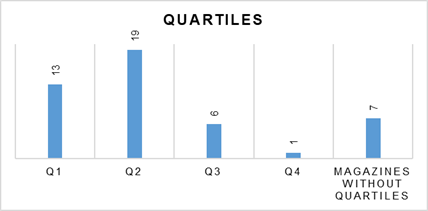
Note. Prepared by the authors.
The magazines belonging to Q1 and Q2 are the ones with the highest impact ratio, while Q3 and Q4 are the ones with the lowest impact (Marín & Arriojas, 2021). It is possible to observe (see Figure 2), that most of the articles analyzed are published in magazines with Q1 and Q2, which indicates that they are publications with better indicators. Similarly, it is shown that 7 of the 56 articles belong to magazines that do not include the quartile system, which are generally magazines that do not belong to Scopus or Web of Science.
Place of origin of publications
In order to know the place where most studies on the topics were conducted altogether, an analysis was made of the country where the research was carried out. For practical purposes and for a better understanding, they were grouped by continents (see Figure 3). It can be seen that the majority belong to the Asian continent, since it accounts for half of the publications with 50% of the total, followed by the European continent with 25%.
In Figure 3, we can graphically observe a large difference in the percentages obtained between the continent with the lowest (Africa) and the highest (Asia) number of documents.
This is due to the fact that the continents with the lowest percentages are America with 21.43% and Africa with 3.57%, being the two with the lowest productivity of scientific studies published in the databases on organizational learning and performance over the last ten years.
Figure 3
Origin by continent
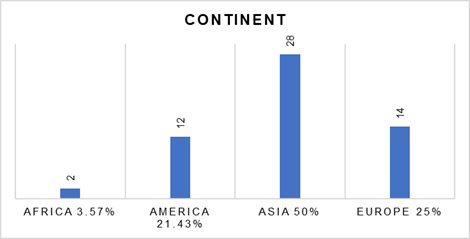
Note. Prepared by the authors.
Although, the variables all together have not been investigated as expected in the given period (2011-2021); it is necessary to mention that according to Londoño-Patiño and Acevedo-Álvarez (2018) the importance of this type of studies lies in the fact that being a learning organization, implies that employees understand what they should do and perform their activities efficiently, which, generates a higher performance. In other words, the relevance of organizational learning lies mainly in increasing efficiency with the support of the creation and generation of
knowledge, achieving greater profitability and the continuity of the companies.
Out of the 56 documents reviewed, only 12 were obtained in America (see Figure 3), only four of them are published in Spanish, from which two studies come from Latin American databases, specifically Redalyc and Scielo, it is worth noting that in the entire search only these two articles were found in these databases. This could indicate that these countries still do not give the necessary interest and importance to the variables, showing a possible gap in knowledge that could be studied by the scientific community in order to enrich the information both empirically and theoretically.
In conclusion, research was found on organizational learning and performance analyzed from different points of view (for example, individual, organizational, business, financial, non-financial, among others); however, some mentioned the variables in their title, but there was no information on the subject in the rest of the document or evidence of having studied the topic, so they were discarded. Likewise, throughout the search in the databases, other publications were found that studied it individually and were not considered for the present review, since one of the criteria for inclusion in the present analysis specified that they should consider both.
Studies by year
To identify the existence of an evolution in the number of annual publications and to know the years in which the highest and lowest productivity was obtained (see Table 1), we proceeded to calculate the number of studies and the equivalent percentage for each year, which are presented below.
The purpose of this was to observe whether publications are increasing or decreasing as time goes by, and also to look for evidence as to whether this is a topic that has become more relevant and popular in the last ten years or whether the academy and entrepreneurs have simply lost interest in studying it altogether.
Table 1
Published studies per year
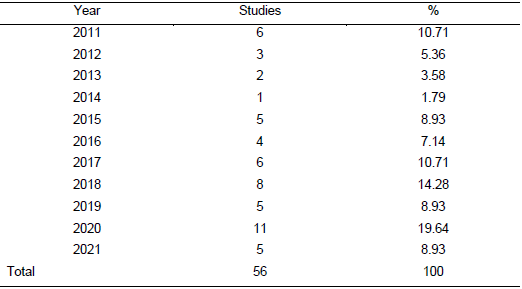
Note. Prepared by the authors.
After analyzing the results (see Table 1), it was not possible to identify the existence of an evolution or a continuous growth of publications in the established period as expected, i.e. the number of articles did not increase or decrease as the years went by, since they varied without any sequence. However, it is possible to observe that the year with the highest number of articles was 2020 with 11, which equal to 19.64%. It was expected that in 2021 it would result with a similar percentage or that it would increase, however this was not the case, which could mean that these researches have not yet been published or are in other databases to which there is no access.
In second place was 2018 with 14.28%, in third place were in 2011 and 2017 with 10.71% respectively, showing a little significant difference in the numbers compared to 2020. On the contrary, in 2014 was the year with the lowest number of publications, since only one publication was found in that year, which is equivalent to 1.79% of the total, which does show a significant difference between the first years and 2020.
Approach of the studies
Regarding the approach used in the articles selected for this review, 52 of them are empirical and only four are theoretical. Of which (see Table 2), most are quantitative, i.e., out of 40 publications 36 used a quantitative methodology, only two were qualitative, the first was in Europe (Kopp, et al., 2020) and the second in America (Olejarski, et al., 2018), one with a mixed approach in Europe (Kleefstra, et al., 2020).
With the results of this section, it is possible to identify an area of opportunity and interest for future studies on the variables, both in the qualitative and in the mixed approach, due to the fact that not so many published articles were found in these approaches.
Table 2
Approach of the studies
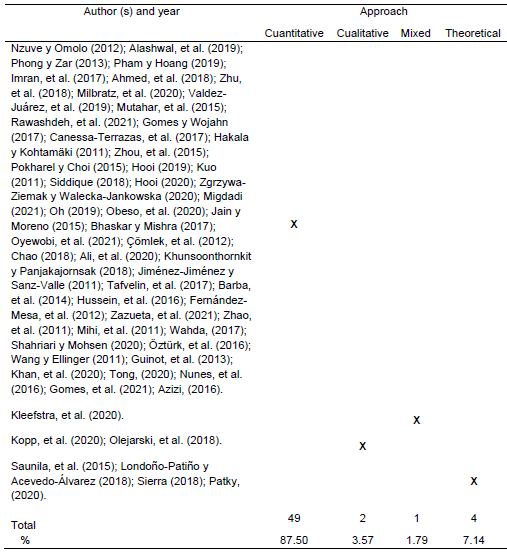
Note. Prepared by the authors.
It is necessary to emphasize and understand that the quantitative approach is not the only or the best approach to conduct research on organizational learning and performance overall, however, according to the findings of this systematic literature review, it is the most widely used in the last ten years. In addition, it is advisable to use other approaches to analyze it from another point of view to expand the information and generate greater empirical contribution in different sectors and countries.
For example, Martínez-Aragón, et al. (2022) mention that studying the variables with a qualitative approach would be the starting point for observing other perspectives that would allow contrasting and complementing the results of existing studies. However, it is important to note that although they are different approaches, they should not necessarily be studied separately, since by using both, it is possible to visualize certain aspects that might not be possible with just one approach.
It is expected that as time goes by, the importance of this research will be highlighted and that articles with different methodological approaches (specifically qualitative and mixed) will be incorporated to enrich the theory and empirical information already existing in the databases. Furthermore, it is expected that other variables will be incorporated into the studies in order to go deeper into the topic and identify possible correlations, including the development of models, with the purpose of continuing with studies that allow the understanding of a phenomenon and thus propose processes or proposals for improvement that are useful for organizations.
Incorporation of other variables
As mentioned above, this document focused only on the analysis of studies that contemplated organizational learning and performance; however, some articles incorporated other variables in their research (see Figure 4) due to the possible relationship, versatility and interest on other topics.
It is noteworthy that most of them added topics such as innovation, knowledge management and market, business and entrepreneurial orientation. It was also found that in some of the analyzed studies, which incorporated other topics, that organizational learning served as a mediating variable. Meaning that it was the one that facilitated the understanding of how one variable affects another and what is prevailing the relationship presented (Fernández-Mesa, et al., 2012; Imran, et al., 2017; Valdez-Juárez, et al., 2019; Hooi, 2020; Obeso, et al., 2020).
Figure 4
Inclusion of other variables
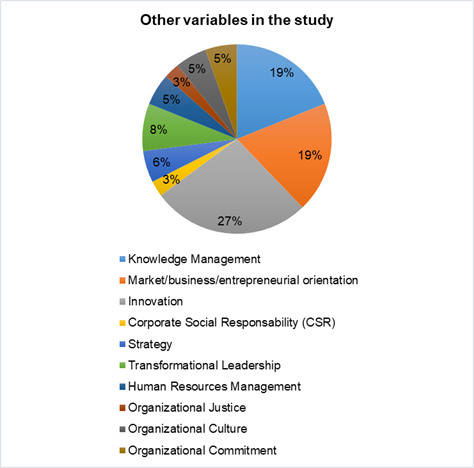
Note. Prepared by the authors.
Thanks to the results shown in the analyzed articles, it has been possible to confirm and conclude that there is a correlation between organizational learning and performance in different sectors and countries around the world. Some studies even added other variables such as: knowledge management (Imran, et al., 2017; Kuo, 2011; Obeso, et al., 2020; Jain & Moreno, 2015; Mihi, et al., 2011; Wahda, 2017), entrepreneurial orientation (Zhu, et al., 2018; Fernandez-Mesa, et al., 2012; Zhao, et al., 2011; Nunes, et al., 2016; Gomes, et al., 2021), market orientation (Ahmed, et al., 2018), entrepreneurial orientation (Hakala & Kohtamäki, 2011), innovation (Milbratz, et al., 2020; Gomes & Wojahn, 2017; Migdadi, 2021; Çömlek, et al., 2012; Chao, 2018; Jiménez-Jiménez & Sanz-Valle, 2011; Hussein, et al., 2016; Fernández-Mesa, et al., 2012; Wang & Ellinger, 2011; Patky, 2020), Corporate Social Responsibility (Valdez-Juárez, et al., 2019), among others.
CONCLUSION
As time goes by, organizations have evolved both in their processes and in the ways of managing themselves to become more efficient and competitive, in order to face their competitors and adapt to the environment in which they are immersed. To achieve this, they have considered different factors, organizational learning being one of them. This is because the companies that have been learning are the ones that are more concerned about their members acquiring and sharing their knowledge with others so they can carry out their activities efficiently and thus increase the performance of the organization.
In addition, it should be noted that performance has also been studied in recent years. However, different types were found and it is necessary for the authors to specify which type they are considering, since this can create confusion. There were even papers that were discarded for this article, since the title mentioned performance, but did not go into further detail. Among the studies analyzed, the most recurrent were: individual, organizational, financial, non-financial, commercial and business performance, among others. This shows the current need to create a common understanding and classification of the types of performance, which will allow researchers to focus and not create confusion among readers.
In this systematic literature review, it was possible to observe the number of researches that incorporated organizational learning and performance altogether in the period 2011-2021. The Asian continent being the largest producer of scientific articles in databases and indexed magazines, highlighting countries such as Malaysia, Turkey, Jordan, India, Pakistan, among others. Moreover, indicating that the nations belonging to Asia are the ones that have been more concerned about these aspects compared to other continents and they seek alternatives such as learning in order for their organizations to increase their performance, which, has allowed the companies of the mentioned continent, to achieve better results.
From all the articles analyzed in this paper, only three were conducted in Mexico, the first one (Valdez-Juárez, et al., 2019) was focused on small and medium-sized enterprises (SMEs) in the primary, secondary and tertiary sectors, which included corporate social responsibility with a quantitative approach. To analyze and validate their results, they used a statistical technique of structural equation modeling, and it was found that organizational learning served as a mediating variable in the study and that it is an essential factor to increase the companies´ performance (specifically financial performance), confirming what has been previously mentioned.
The second paper in Mexico, was conducted in small and medium-sized business companies (Zazueta, et al., 2021), which by means of a simple linear regression model demonstrated that organizational learning influences organizational performance. Finally, a literature review paper was found in Mexico (Sierra, 2018) that incorporated entrepreneurship and organizational commitment, alluding that there is a relationship between the variables. With the aforementioned studies, relationships and influences between organizational learning and performance were demonstrated, in addition, it was possible to find areas of interest for future organizational studies.
In this sense, by analyzing the previous articles, it was observed that the variables have been scarcely approached, mainly in Latin American countries; in addition, an increase in publications on the subject is expected. Furthermore, the qualitative and mixed approaches were studied to a lesser extent. Therefore, an investigation of both variables has the potential to be innovative and interesting for researchers and professors, as well as for businessmen and managers who wish to increase the performance of their organizations.
Likewise, it is recommended to perform a separate and individual systematic literature review for each variable, focusing on the sectors where they have been studied, the conceptualizations, theoretical evolutions, as well as the instruments used, since these were aspects that were not considered in this document and that, as mentioned, are of interest to different groups of people. It is also suggested that in the future a new review should be conducted where both topics are considered, since in the present one only database documents to which access was available were analyzed, which slightly limited the study.
Finally, a total of 12 articles were found in the Americas, of which only three were conducted in Mexico. Of the documents found in the Americas, four were published in Spanish and in Latin American databases. This indicates that the region does not give enough importance to the variables; it is suggested to the community to be informed and pay more attention to the topics presented in order to ensure that organizations perform better and seek learning processes to generate competitive advantages that position them in the market. In addition, throughout the document some gaps in knowledge have been identified that could be of interest for the scientific and student community to investigate and enrich the existing information.
REFERENCES
Please refer to articles in Spanish Bibliography.
BIBLIOGRAPHICAL ABSTRACT
Please refer to articles Spanish Biographical abstract.